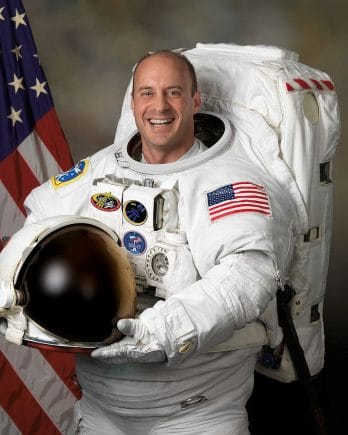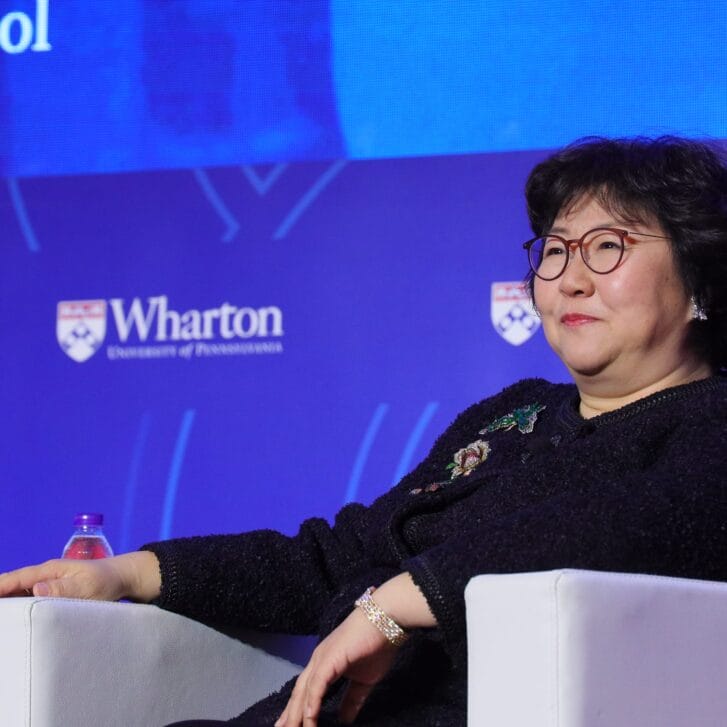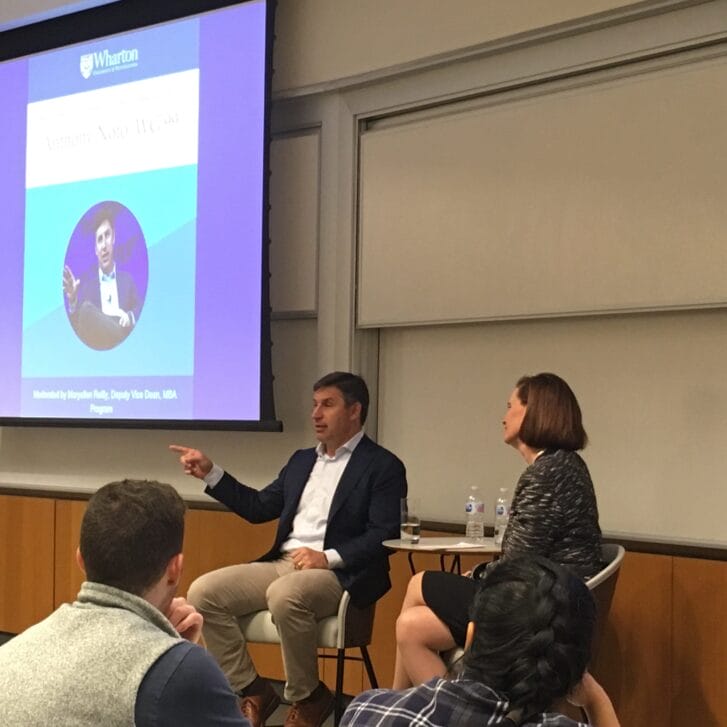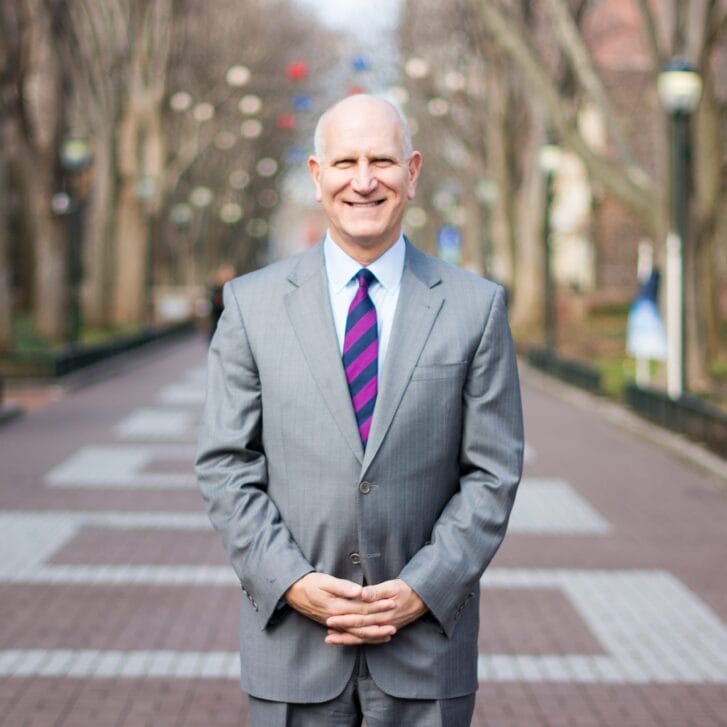It looked like a scene from countless sci-fi thrillers—the astronaut stranded in space. But for Garrett Reisman ENG90 W90, this wasn’t a cameo in a Hollywood blockbuster. The NASA astronaut was on a mission aboard the space shuttle Atlantis in 2010 and perched on the end of a robotic arm at the International Space Station. Two hours into a marathon seven hour spacewalk, a power outage left him stuck. Making the situation even more intense, the sun and the moon were out of sight; Reisman was surrounded by the deepest blackness he’d ever seen. His reaction: “You don’t get a break very often, so I’m thinking, ‘This is nice,’” Reisman recalled, in a conversation with the dean of Penn Engineering, Vijay Kumar, at the Wharton Global Forum in New York in June. All Reisman could see, he said, was his commander through a window making a certain astronomy-themed gesture to keep him calm and inspire a laugh.
That, in a nutshell, is Reisman—someone who, for all of his accomplishments, hasn’t lost his sense of wonder about the universe around us or his sense of humor, even when floating helplessly above the Earth. Over the course of more than a decade with NASA, the 50-year-old New Jersey native flew on all three remaining shuttles and performed three spacewalks. In 2011, he joined SpaceX, eventually becoming its Director of Space Operations, and worked closely with founder (and fellow Whartonite) Elon Musk. Earlier this year, Reisman announced his latest adventure—joining the faculty at the University of Southern California as a professor of astronautical engineering, while taking on a senior advisory role with SpaceX. Wharton Magazine caught up with Reisman—clad in his blue NASA flight jacket and astronaut-themed socks—after his Global Forum appearance to discuss his success trajectory, the booming space industry, and his thoughts on our (not-so-distant) future beyond this planet.
Wharton Magazine: You’re one of 536 people to travel into space. Can you talk about why you’re so passionate about doing this very exclusive and very difficult job?
Garrett Reisman: People ask me if I always wanted to be an astronaut, and the answer is yes. I just never thought it would be possible. I was hooked from an early age, and I loved math and physics and everything required to do it. But I had a mom that was scared of flying. [laughs] I told her I was thinking about joining the Air National Guard at Marrakesh restaurant in Philly over Parents Weekend—she freaked out. But during my fifth year—I was a five-year M&T [Jerome Fisher Program in Management and Technology]—it dawned on me that astronauts are not all military test pilots, that maybe there is a path that works for me. That was my “eureka” moment. I went to the bookstore and found a poster of the Apollo 8 photo of the Earth rise that [astronaut] Bill Anders took as they came around the backside of the moon. I put that up above my desk as a reminder of what all this hard work was for. I said one day I’m going to hang this up at the Johnson Space Center, and I did. I took it to SpaceX and one day, Bill Anders came for a tour. I showed him his picture on the wall, told him this whole story, and he said, “Aww, isn’t that cute.” He signed it for me. I still have it.
WM: What’s the experience of seeing the Earth from space for the first time?
GR: My first mission, I was on Endeavor and there was only one window downstairs. It’s about the size of a dinner plate. You’ve got all this work to do so right away I got down to business. About half an hour went by, and then I saw a pale blue glow coming from the corner, and I realized, “Oh wow, that’s the Earth, I should go have a look at it.” I expected this to be really transformative, so I paused, closed my eyes, got ready, and floated up to that window. I looked out and the best way I could describe what it felt like in that moment would be to say, “Meh.” [laughs] The reality was kind of a letdown. You had the Earth colors, browns and blues and greens. Some of the video we’ve got coming down now, you can see the auroras and all these beautiful light shows coming from space. It’s better than what you can see from the naked eye.
WM: Was your first spacewalk more of a “wow” moment?
GR: Much more. You’re immersed, in that giant fishbowl of a helmet, and that experience is actually completely overwhelming. There’s a new window on the [International] Space Station called the Cupola, and we tell everyone who doesn’t do a spacewalk that the view out of that Cupola is just as good. It’s a beautiful dome, it’s kind of a 360 view, and it is spectacular—but it’s not as good. Don’t tell anybody. [laughs] What’s really impressive was not looking down, but looking at the horizon. You see this thin blue line that separates the sun-lit Earth from the blackness of space, and that’s the atmosphere, that’s all the air we have to breathe. Compared to the diameter of the Earth, it’s tiny. It looks so incredibly fragile. And all the black stuff is a vacuum, right? It looks like a breeze could come by and strip it all away. It’s scary. And you realize how finite it is and how it’s definitely within our power to mess it up. When I look at the sky and the oceans, it doesn’t seem vast and limitless. It seems like something that we as a human race have the ability to destroy.

Reisman during his tenure with NASA. (Photo: NASA)
WM: We tend to look at astronauts as natural leaders. Is that a role you grew into naturally or a skill you worked to develop?
GR: Leadership is very important. It’s something that we practice and emphasize and think about. But followership is something that isn’t talked about. In any good organization, there are way more followers than there are leaders. And having good followers is often much more important than having the one good leader at the top. As a crew on space station, it’s really important to be a good follower. You want to be competent with your job, have some sense of self-management. We practice that as astronauts when we do survival training. It’s very important that when you wake up in the morning, you are ready to go when the group is ready to go. You’re never the one that everybody is waiting on. When you lead, you lead by example, to motivate rather than say “I’m the boss.” You have to be willing to work harder than anybody, you have to be willing to do the things that no one else wants to do. One of the best examples of good leadership was in our survival training. When this Italian air force pilot was the leader, he was the first one up in the morning, he scouted our path for the day, and before we woke up he had already accomplished about half the day’s activities. He was also the last one to go to sleep.
WM: And when a crisis hits, like getting stuck on a mechanical arm during a spacewalk—
GR: You can’t have a focus group. At the moment, I didn’t feel any immediate danger. But my mobility was limited. I knew that if something should go wrong, if I should have a leak in my suit or a failure with one of the suit’s components or systems, and I had to rapidly get back to the airlock, I was gonna be hard-pressed to do that. And there was a possibility I was going to have to go untethered at a certain spot to get that done. That was very disconcerting. I was stuck there for about 45 minutes.
WM: Probably felt like hours.
GR: It felt like a really long time.
WM: When you were at SpaceX, you worked with NASA to certify the Dragon 2 spacecraft. What are the differences in culture between the two organizations and how did you help them work more efficiently together?
GR: There are very different cultures at those organizations and it was a challenge to get them to work together. But it was really important that they did, because the benefits were tremendous. In retrospect, both organizations realized they got better. SpaceX is very much a startup with Silicon Valley DNA and all about doing things differently and more efficiently. Elon [Musk] would tell us our job, every single day, is to come up with a way to do things better. That’s very different from the approach at NASA, where there’s a concern that if you proceed too quickly it could be dangerous, that you could introduce risk by moving too fast. If you take either approach too far, bad things could happen. What I think we learned is the strengths of each other’s approaches, and when to apply them selectively to do things well.

At Reisman’s SpaceX office was a poster that he bought from the Penn Bookstore as a student in the M&T program. (Photo: SpaceX)
WM: Can you talk about working with Elon Musk and the way he runs his companies, his drive to innovate?
GR: Elon is a very impressive guy, and I’m grateful for the opportunity to work for him and have a front row seat at this very transformative moment. The thing that impresses me the most is his ability to reach very, very, very deep into particular technical topics, but across an incredibly wide scope. He’s the only person I’ve ever seen that can really do it with that level of acumen. He can jump from talking to our electronic experts about the arcane details about the architectures of the processor inside the flight computer, and then talk to our structures guys about a particular type of alloy in their welding techniques. His ability to switch gears and interact at such a very high technical level with experts in each of these subjects, and not only keep up, but surpass them in many cases, is remarkable.
WM: Your newest challenge is in academia. Why did you want to become a professor?
GR: I got to a point after seven years at SpaceX where I thought we had a really good team in place, so I had the opportunity to leave without jeopardizing anything. USC came along with an offer I couldn’t refuse. It’s a very exciting time because the business is booming. When I was an undergraduate at Penn, there wasn’t an opportunity to get a job designing a human-carrying spaceship. The situation in human space flight is totally different now. SpaceX is doing the Dragon, you have Boeing doing the CST-100, Lockheed is building the Orion, Virgin is building SpaceShipTwo, Blue Origin is building New Shepard. It’s only going to grow as we go forward. There’s going to be a demand for engineers that can do human space flight engineering. One piece of advice that was given to me a long time ago was be in a growth industry, and be at the core competence of that growth industry. I feel like that’s what I’m doing right now at USC.
WM: It seems that the industry has shifted from space exploration to space travel—
GR: And utilization. I think Jeff Bezos has an idea to see a heavy industry move to space so that we can clean up the Earth. There’s also the thought of exploration for the sake of survival as a species. The way Elon describes it is we have a hard drive with no backup. If something happens to this hard drive, we lose all our data. But if we have a backup, a self-sustaining presence on another planet, then we have redundancy. So the idea of travel and space colonization as a survival strategy is compelling.
WM: What do you anticipate being the biggest advancement in space in our lifetimes?
GR: I hope we see the beginning at least of a permanent presence on Mars. I really think that’s the most practical destination if you want to start a sustainable colony. You have a lot of in situ resources on Mars that you don’t have on the moon or in other places. You can create fuel because there’s a lot of water on Mars; there’s a lot of hydrogen and oxygen in the air, you can combine that with carbon dioxide in the atmosphere and create methane. You also have gravity on Mars, which is really important for human biology.
WM: What are your thoughts on the possibility of finding life beyond Earth?
GR: Just recently there was a discovery that came back from the rover up on Mars. Two things: they found methane in the atmosphere, and a chemical analysis of rocks found some organics on the surface. So we’re getting closer and closer. It’s almost like a Hollywood movie and you’re getting all this foreshadowing. It seems that in our lifetime, it’s more likely than not that we’ll find life on Mars. I’m not talking about little green men—I’m talking about microbial life, some form of a non-terrestrial organism.
WM: What do you see unfolding in the space industry in the near future?
GR: Certainly in the next five years, commercial orbital human spacecraft. Then we scale up from there and have ships that can go up to Mars and back to the moon, and those missions that take us out of low Earth orbit with people.
WM: Can you share some experiences from your time at Wharton that you’ve carried with you through the years?
GR: There’s two things—one was the classes I took in decision sciences. Because really what it comes down to, when you talk about human operating a spacecraft, all of that gets back to the basics of decision sciences. How do humans make decisions, how do they process information? I learned a lot of that as a Wharton undergrad. And then statistics are extremely important when you are analyzing data and making decisions about “Is this safe?” or “Should we add redundancy to this thing, or should we add reliability?” Those statistics classes at Wharton, I would love to teach those same classes to my engineers. I think they would really benefit from it.
WM: Any last thoughts you’d like to end with?
GR: We were very interested in recruiting M&Ters at SpaceX to come work for us. It’s just such a great program, and Gad [Allon] who’s heading it up now is doing a great job. I would wrap up with a shoutout to some people who were really influential from my time at Penn. One of them is William Hamilton. Professor Hamilton was the creator of the M&T program and an incredible mentor for me. I still talk to him. Same goes for Joe Bordogna, who was the dean of the engineering school at the time. Those two individuals really profoundly shaped my life—none of the stuff I’m talking about would’ve happened if it weren’t for their influence, so I have a great deal of gratitude for both of those men.
WM: That’s a common thread among people who’ve achieved success like you have—the presence of meaningful mentors.
GR: And if one person someday says that about me, as I’m now a professor at USC, then I’m done. [laughs] That’s my goal now.
Editor’s note: For more on Reisman’s career, visit GarrettReisman.com and AstronautGarrettReisman.com and follow him on Twitter at @astro_g_dogg. This transcript has been condensed and edited.


























